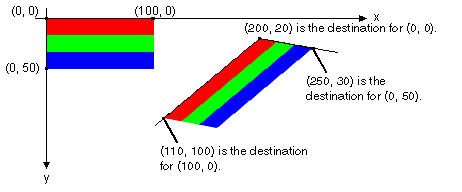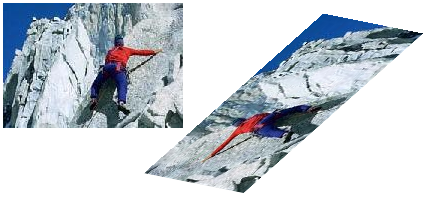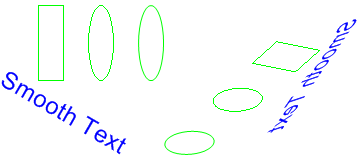如何:旋轉、反射和傾斜影像
您可以指定原始影像左上角、右上角和左下角的目的地點,來旋轉、反映和扭曲影像。 三個目的點會決定將原始矩形影像對應至平行投影的仿射轉換。
範例
例如,假設原始影像是左上角為 (0, 0), 右上角在 (100, 0), 左下角為 (0, 50) 的矩形。 現在假設您將這三個點對應至目的地點,如下所示。
| 原始點 | 目的地點 |
|---|---|
| 左上方 (0, 0) | (200, 20) |
| 右上方 (100, 0) | (110, 100) |
| 左下角 (0, 50) | (250, 30) |
下圖顯示原始影像和對應至平行投影的影像。 原始影像已扭曲、反映、旋轉和翻譯。 沿著原始影像上邊緣的 X 軸會對應到執行到 (200, 20) 和 (110, 100) 的線條。 沿著原始影像左邊緣的 Y 軸會對應至穿過 (200, 20, 20) 和 (250, 30) 的線條。

下圖顯示套用至攝影影像的類似轉換:

下圖顯示套用至元檔的類似轉換:

下列範例會產生第一個圖例中顯示的影像。
Point[] destinationPoints = {
new Point(200, 20), // destination for upper-left point of
// original
new Point(110, 100), // destination for upper-right point of
// original
new Point(250, 30)}; // destination for lower-left point of
// original
Image image = new Bitmap("Stripes.bmp");
// Draw the image unaltered with its upper-left corner at (0, 0).
e.Graphics.DrawImage(image, 0, 0);
// Draw the image mapped to the parallelogram.
e.Graphics.DrawImage(image, destinationPoints);
' New Point(200, 20) = destination for upper-left point of original
' New Point(110, 100) = destination for upper-right point of original
' New Point(250, 30) = destination for lower-left point of original
Dim destinationPoints As Point() = { _
New Point(200, 20), _
New Point(110, 100), _
New Point(250, 30)}
Dim image As New Bitmap("Stripes.bmp")
' Draw the image unaltered with its upper-left corner at (0, 0).
e.Graphics.DrawImage(image, 0, 0)
' Draw the image mapped to the parallelogram.
e.Graphics.DrawImage(image, destinationPoints)
編譯程式碼
上述範例是專為搭配 Windows Forms 使用而設計,而且需要 PaintEventArgs e,這是事件處理程式的參數 Paint 。 請務必將 取代 Stripes.bmp 為您系統上有效映像的路徑。
另請參閱
意見反應
即將登場:在 2024 年,我們將逐步淘汰 GitHub 問題作為內容的意見反應機制,並將它取代為新的意見反應系統。 如需詳細資訊,請參閱:https://aka.ms/ContentUserFeedback。
提交並檢視相關的意見反應
